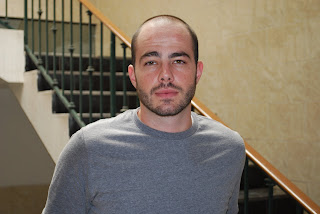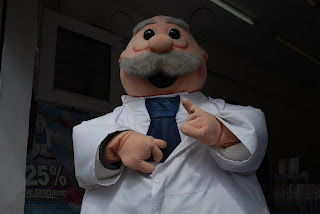
Dan Brown is 41. He was born in the United States, grew up in Mexico until he was nine-years-old, and then moved back to California. He is bilingual. He's been at CulturLingua since the middle of August but has been in Mexico since last year. Dan has taught for eight years becaues he finds it rewarding and he likes it. Dan teaches Beeline 2, which is composed of 12 young boys and girls. Dan has also travelled to Canada, the Bahamas, Belize, Guatemala, Spain, and Japan. Dan likes the relaxed atmosphere of Sahuayo. He says the neighbors are friendly and he enjoys the interaction. His purple hair is a testamount to his eccentric tastes. He plays music at bars in and around Sahuayo. He says he's the black sheep of his family.

Ricardo is the coordinator of CulturLingua. He recruits new students, deals with parents and misbehaving students, but most of all, helps the teachers. He makes copies, procures materials, and contacts Cecilia, the coordinator, on a daily basis. He opens and closes the school. Without him, we wouldn't be able to do our jobs.
He's 37-years-old and was born in Sahuayo. He hasn't always lived here, however. He moved to the United States when he was18. He worked in various kitchens in Neveda, Arizona, and California. In 2004 he came back. He's single and has no family. He's been at CulturLingua for a year. "I like Sahuayo," he says.

Salvador is our oldest teacher. He's from Los Remedios ("The Remedies"), a town not too far from here. He has lived in Sahuayo since his mother died a couple years ago. He has one daughter (age 13), and one son (17), who suffers from Lou Gehrig's disease. He learned English 30 years ago and speaks it almost as well as any native. He has taught at CulturLingua previously. He also works at another school called CETIS. He relaxes in Los Remedios on the weekends. He teaches us Spanish on Monday, Tuesday, and Wednesday mornings.

Kris is a 24-year-old graduate of the University of Ohio. He's here to learn Spanish, and gain valuable teaching experience, so he can teach Spanish in the United States. He's been in Mexico for two months, and has already been to Guadalajara and Puerto Vallerta. He's been to Canada (Quebec and Niagara Falls), Ecuador, Spain, France, Italy, and Austria.
Kris says Sahuayo is a small town, but a medium-sized city, where everyone knows everything. Gossip travels fast, and people have a penchant for "making stuff up." Kris has found a girlfriend here and plans to stay through next summer. He has a passion for playing guitar, which he plays every night in the living room.
Erika is frombeautiful Cape Town, South Africa. She has no prior teaching experience, and no unveristy degree. She says she's here to "try [teaching] out." She's been here for three months. In fact, she was the one who assured me Sahuayo is safe (she's right). Unfortunately, she cannot extend her visa and will have to go back to South Africa in November. Getting to Sahuayo took her more than a day. Erika has been a vagabound: she worked as a security guard in London. She has also been to Scotland, Paris, Greece, Venice, Berlin, Barcelona, and the following cities in India: New Dehli, Goa, Varanasi, Agra, Jaipur, and the Kerala state. She has no idea what she wants to do with her future.

Angela is the youngest teacher we have. She moved in with Kris, Erika and me two weeks ago. She has no university degree but does have a CELTA. She's 19-years-old and a native of Bellingham, Washington. She's a devout Christian and is leaving at Christmas break to be with her family, as Christmas is very important to her. She's enjoying life in Sahuayo, but it's hard because she doesn't know Spanish. She says teaching is a "good way to travel. It's a relaxed atmosphere." Angela has been to Canada, Hawaii, Mexico (Acapulco and Mazatlan), as well as Laos and Myanmar.
PS- I will have photos of me and Erika in a few days.
 Although Sahuayo is a small Mexican town that you can barely locate on a map, American influence is still pervasive, as these pictures show. Vendors sell American movies and magazines in the streets, and I hear American music blasting in the cars.
Although Sahuayo is a small Mexican town that you can barely locate on a map, American influence is still pervasive, as these pictures show. Vendors sell American movies and magazines in the streets, and I hear American music blasting in the cars.

 Here's the school I work at, CulturLingua. It's on Calle (Miguel) Hidalgo. As you can see, it's not much. There's an open-air patio that gets wet when it rains. Now that it’s winter, there’s no respite from the cold air outside. There are two gates at the front. Ricardo, the coordinator, has a computer, but no internet access. There are few resources here: one printer, one computer, no internet, no copiers, and very few office supplies. We have CD players and white boards in the room. There are only five classrooms, and one functional toliet.
Here's the school I work at, CulturLingua. It's on Calle (Miguel) Hidalgo. As you can see, it's not much. There's an open-air patio that gets wet when it rains. Now that it’s winter, there’s no respite from the cold air outside. There are two gates at the front. Ricardo, the coordinator, has a computer, but no internet access. There are few resources here: one printer, one computer, no internet, no copiers, and very few office supplies. We have CD players and white boards in the room. There are only five classrooms, and one functional toliet.
















































